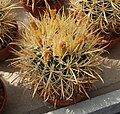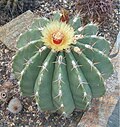Loading AI tools
Genus of cacti From Wikipedia, the free encyclopedia
Ferocactus is a genus of large barrel-shaped cacti, mostly with large spines and small flowers. There are about 30 species included in the genus. They are found in the southwestern United States and northwestern Mexico.
This article includes a list of general references, but it lacks sufficient corresponding inline citations. (May 2016) |
| Ferocactus | |
|---|---|
 | |
| Ferocactus glaucescens | |
| Scientific classification | |
| Kingdom: | Plantae |
| Clade: | Tracheophytes |
| Clade: | Angiosperms |
| Clade: | Eudicots |
| Order: | Caryophyllales |
| Family: | Cactaceae |
| Subfamily: | Cactoideae |
| Tribe: | Cacteae |
| Genus: | Ferocactus Britton & Rose[1] |
| Species | |
|
See text. | |
| Synonyms | |


The young specimens are columnar but as they grow older ribs form and they take on a barrel form. Most of the species are solitary but some, such as Ferocactus robustus and F. glaucescens, have clustering habits. The flowers are pink, yellow, red or purple depending on the species, and the petals sometimes have a stripe of a darker colour.
They are desert dwellers and can cope with some frost and intense heat. The typical habitat is hot and very arid, and the plants have adapted to exploit water movement to concentrate their biomass in areas where water is likely to be present. Like Sclerocactus, Ferocactus typically grow in areas where water flows irregularly or depressions where water can accumulate for short periods of time. They are most often found growing along arroyos (washes) where their seeds have been subjected to scarification due to water movement, but they oddly also tend to grow along ridges in spots where depressions have formed and can hold water for some period of time.
Ferocactus have very shallow root systems and are easily uprooted during flash floods. The "fishhook" spines and the armored web of spines enclosing the cactus body in many species of this genus are adaptations which allow the plant to move to more favorable locations. The seeds germinate in areas where water movement occurs or in areas where standing water accumulates for some period of time, and during flash floods, the hooked spines allow the plants to be caught on waterborne debris, uprooted and carried to areas where water tends to accumulate.
In cultivation Ferocactus require full sun, little water, and good drainage. They are popular as houseplants. They cannot tolerate freezing temperatures for extended periods, which typically cause them to yellow, bleach, then slowly die. Propagation is usually from seeds, but clustering species such as Ferocactus robustus and F. glaucescens can be propagated by removing a rooted offset and planting it.
Many ferocactus species are ant plants, exuding nectar along the upper meristem from extrafloral nectaries above each areole, and hosting ant colonies.
| Section | Image | Scientific name | Common Name | Distribution |
|---|---|---|---|---|
| Section Bisnaga |  | Ferocactus echidne | Sonora Barrel Cactus, Coville's Barrel Cactus, Emory's Barrel Cactus, Traveler's Friend | Mexico |
 | Ferocactus flavovirens | Mexico. | ||
 | Ferocactus glaucescens | Hidalgo, México. | ||
 | Ferocactus haematacanthus (Salm-Dyck) Bravo ex Backeb. & F.M.Knuth[2] | Mexico. | ||
 | Ferocactus hamatacanthus (Muehlenpf.) Britton & Rose | Turk's-Head Barrel Cactus, Biznaga-barril Costillona | Chihuahuan Desert of north-western Mexico, New Mexico, and south-western Texas. | |
 | Ferocactus histrix (DC.) G.E.Linds. | Electrode Cactus | Mexico. | |
 | Ferocactus latispinus (Haw.) Britton & Rose | southeastern Durango, through Zacatecas, Aguascalientes, east to the western parts of San Luis Potosí, Hidalgo and Puebla, as well as to eastern Jalisco, Guanajuato, Querétaro and Mexico State. | ||
 | Ferocactus lindsayi | Mexico (Michoacán, Guerrero) | ||
 | Ferocactus macrodiscus | Mexico. | ||
 | Ferocactus schwarzii | Schwarz's Barrel Cactus | Mexico. | |
| Section Ferocactus |  | Ferocactus alamosanus | Mexican state of Sonora, in northwestern Mexico | |
 | Ferocactus chrysacanthus | Mexico. | ||
 | Ferocactus cylindraceus (Engelm.) Orcutt | California Barrel Cactus, Biznaga-barril cilíndrica | eastern Mojave Desert and western Sonoran Desert Ecoregions in: Southern California, Nevada, Arizona, and Utah in the Southwestern United States; and Baja California, and Sonora state in Northwestern Mexico. | |
 | Ferocactus diguetii | Mexico. | ||
 | Ferocactus emoryi (Engelm.) Orcutt | Emory's Barrel Cactus, Biznaga-barril de Emory | Mexico (Sonora, Sinaloa and Baja California Sur) and in the United States (Arizona). | |
 | Ferocactus fordii | Baja California in Mexico. | ||
 | Ferocactus gracilis H.E.Gates | Fire Barrel Cactus | Mexico. | |
 | Ferocactus herrerae | Twisted Barrel Cactus | Mexico (Sinaloa, Sonora) | |
 | Ferocactus johnstonianus Britton & Rose | Johnston's Barrel Cactus | Angel de la Guardia Island, Baja California, Mexico. | |
 | Ferocactus mathssonii | Mexico (Guanajuato to San Luis Potosí) | ||
 | Ferocactus peninsulae (F.A.C.Weber) Britton & Rose | Mexican state of Baja California Sur. | ||
 | Ferocactus pilosus | Mexican Lime Cactus, Viznaga de Lima | Méxican states of Coahuila, Durango, Nuevo Leon, San Luis Potosí, and Tamaulipas | |
 | Ferocactus pottsii | Mexico. | ||
 | Ferocactus robustus | Puebla and Veracruz in Mexico. | ||
 | Ferocactus santa-maria | Santa-Maria Barrel Cactus | Mexico. | |
| Ferocactus tiburonensis | Mexico (Gulf of California: Tiburon Island) | |||
 | Ferocactus townsendianus | Townsend Barrel Cactus | Mexico. | |
 | Ferocactus uncinatus (Galeotti) Britton & Rose | Mexico, New Mexico, Texas | ||
 | Ferocactus viridescens (Torr. & A.Gray) Britton & Rose | San Diego Barrel Cactus, Biznaga-barril Verdosa | northern Baja California, Mexico and California | |
 | Ferocactus wislizeni (Engelm.) Britton & Rose | Fishhook Barrel Cactus, Candy Barrel Cactus, Biznaga-barril de Nuevo México[2][3] | southwestern United States and northwestern Mexico. | |
Seamless Wikipedia browsing. On steroids.
Every time you click a link to Wikipedia, Wiktionary or Wikiquote in your browser's search results, it will show the modern Wikiwand interface.
Wikiwand extension is a five stars, simple, with minimum permission required to keep your browsing private, safe and transparent.